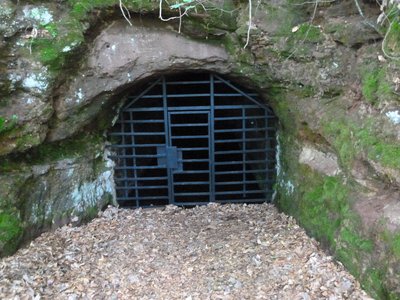
Ramstein circuit
Description
From the car park, go up the main street on the left.
Turn right on Ramstein Street. At the height of the dike of the lake, turn left and go up the path following the green ring. Then go around the pond of Baerenthal on the right along the road through the locality Rosselhof.
At the place called Fischerhof, go up on the right following the yellow diamond after the small fishing pond. At the top of the climb, take the path that climbs to the right and leads to a wide forest path. Turn left to wind it up.
At the junction, turn right to join the Silberbrunnel following the green ring towards Baerenthal through the Ramstein ruins. At the Petit Dunkelthal pass, go down the green ring road towards the Ramstein ruins. Access to the castle is via the stairs along the rock faces. Superb panorama from the platform! Then go down to Baerenthal passing the Ramstein underground. When you reach the village, go down Ramstein street and turn left into the main street to reach the car park. Ability to continue on the main street to see the statue of the Bear of Baerenthal, symbol of the town in front of the town hall, before returning to the parking.
- Departure : Parking main street of Baerenthal
- Arrival : Parking main street of Baerenthal
- Towns crossed : Baerenthal
7 points of interest

Étang de Baerenthal - Adrien Dorschner  Pond
PondBaerenthal Lake
This pond of the North Zinsel basin of 19 ha, already present in 1576 under the name of Schmalenthalerweiher, is one of the oldest ponds of the Pays de Bitche. Originally used to feed the forges, it is now a fishing place, ornithological reserve and base for recreation and swimming (Ramstein beach). It is located in a territory classified "World Biosphere Reserve" by UNESCO.
 Wildlife
WildlifeHighland cattle
When the peasant-workers who mowed the wetland meadows disappeared, the latter evolved into shrubby wasteland, or even forests, threatening the ecological balance of the area. Thus, in 1991, Highland cattle, adapted to wet soils, difficult to access and satisfied with grass of low palatability, were introduced in the Northern Vosges to maintain these wastelands. The first four cattle were introduced in Baerenthal.
La Source d'Argent - PNRVN - A.Serylo  Small patrimony
Small patrimonySilver fount
This spring, which takes its name from Silberberg, the mountain from which it springs, is an ideal place to take a break thanks to the bench located nearby. A legend says there would be a chest containing silver coins hidden nearby.
Col du Petit Dunkelthal - Adrien Dorschner  Mountain pass
Mountain passPetit Dunkelthal Pass
Located in the North-East of the Moselle, it is the second lowest pass of the forest roads after its neighbor, the Grand Dunkelthal, with 299 meters of altitude. It offers nevertheless a very nice view.
Point de vue sur la vallée et Baerenthal, depuis la plate-forme - PNRVN - A.Serylo  Castle-church-abbey
Castle-church-abbeyRamstein fortified Chateau
Built at the end of the 13th century by the Lords of Winstein, Ramstein Castle was intended to control or prohibit access to the Zinsel Valley. But during the 14th century, the lords of Ramstein transformed their castle into a veritable den of brigands, pillaging and ransoming the entire region. Faced with this situation, the people of Strasbourg, with the help of their Bernese allies, organized a punitive expedition against the fortress and destroyed it in 1335.
Une des entrées du souterrain, close par une grille spéciale "chauve-souris" - PNRVN - A.Serylo  Wildlife
WildlifeRamstein Underground Passage
These former military undergrounds served as a shelter for the inhabitants of Baerenthal during the fighting of the winter of 1944-45. Consisting of two parallel galleries connected by four shorter galleries, their entries have been closed since 1990 by special "bat" grids. Indeed, the temperature and the humidity during the winter are favorable to the hibernation of these animals. 11 different species were observed there.
 Castle-church-abbey
Castle-church-abbeySainte-Catherine Church
Built in the 15th century by the Count of Bitche Deux-Ponts, it became Protestant in 1571 after the Count of Hanau-Lichtenberg became the owner of the village. Partly destroyed during the Thirty Years' War, it was rebuilt but damaged again in 1945. It was then restored. A choir was built and the gothic windows were brought to light.
Forecast
Altimetric profile
Sensitive areas
- Impacted practices:
- Aerial, , Land, Vertical
- Sensitivity periods:
- JanFebMarAprMayJunJulAugSepOctNovDec
- Contact:
- Email : contact@parc-vosges-nord.fr Tél. : 03 88 01 49 59
Information desks
Tourist Office of the Pays de Bitche
2 avenue du Général De Gaulle, 57230 Bitche
Access and parking
Report a problem or an error
If you have found an error on this page or if you have noticed any problems during your hike, please report them to us here:
